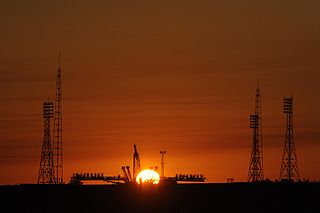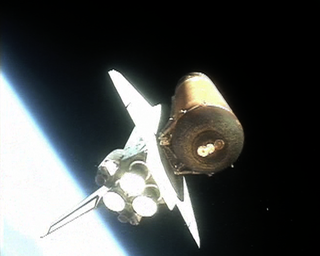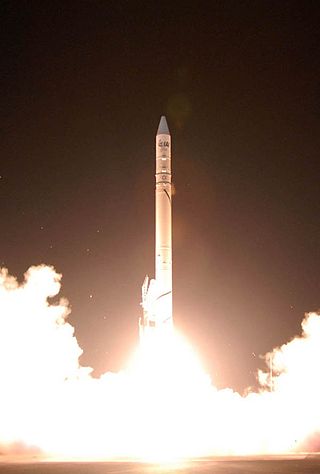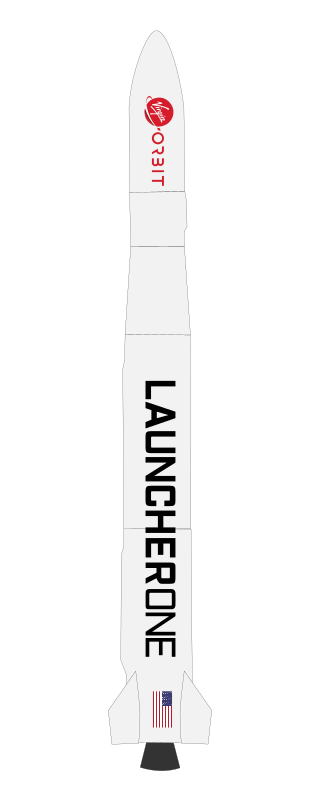Related Research Articles

A spaceport or cosmodrome is a site for launching or receiving spacecraft, by analogy to a seaport for ships or an airport for aircraft. The word spaceport, and even more so cosmodrome, has traditionally been used for sites capable of launching spacecraft into orbit around Earth or on interplanetary trajectories. However, rocket launch sites for purely sub-orbital flights are sometimes called spaceports, as in recent years new and proposed sites for suborbital human flights have been frequently referred to or named "spaceports". Space stations and proposed future bases on the Moon are sometimes called spaceports, in particular if intended as a base for further journeys.
Human spaceflight programs have been conducted, started, or planned by multiple countries and companies. The age of manned rocket flight was initiated by Fritz von Opel who piloted the world's first rocket-propelled flight on 30 September 1929. All space flights depend on rocket technology; von Opel was the co-designer and financier of the visionary project. Until the 21st century, human spaceflight programs were sponsored exclusively by governments, through either the military or civilian space agencies. With the launch of the privately funded SpaceShipOne in 2004, a new category of human spaceflight programs – commercial human spaceflight – arrived. By the end of 2022, three countries and one private company (SpaceX) had successfully launched humans to Earth orbit, and two private companies had launched humans on a suborbital trajectory. The criteria for what constitutes human spaceflight vary. The Fédération Aéronautique Internationale defines spaceflight as any flight over 100 kilometers (62 mi). In the United States professional, military, and commercial astronauts who travel above an altitude of 80 kilometers (50 mi) are awarded the United States Astronaut Badge. This article follows the FAI definition of spaceflight.

A spaceplane is a vehicle that can fly and glide like an aircraft in Earth's atmosphere and maneuver like a spacecraft in outer space. To do so, spaceplanes must incorporate features of both aircraft and spacecraft. Orbital spaceplanes tend to be more similar to conventional spacecraft, while sub-orbital spaceplanes tend to be more similar to fixed-wing aircraft. All spaceplanes to date have been rocket-powered but then landed as unpowered gliders.

A sub-orbital spaceflight is a spaceflight in which the spacecraft reaches outer space, but its trajectory intersects the atmosphere or surface of the gravitating body from which it was launched. Hence, it will not complete one orbital revolution, will not become an artificial satellite nor will it reach escape velocity.

The Kármán line is a proposed conventional boundary between Earth's atmosphere and outer space set by the international record-keeping body FAI at an altitude of 100 kilometres above mean sea level. However, such definition of the edge of space is not universally adopted.

An orbital spaceflight is a spaceflight in which a spacecraft is placed on a trajectory where it could remain in space for at least one orbit. To do this around the Earth, it must be on a free trajectory which has an altitude at perigee around 80 kilometers (50 mi); this is the boundary of space as defined by NASA, the US Air Force and the FAA. To remain in orbit at this altitude requires an orbital speed of ~7.8 km/s. Orbital speed is slower for higher orbits, but attaining them requires greater delta-v. The Fédération Aéronautique Internationale has established the Kármán line at an altitude of 100 km (62 mi) as a working definition for the boundary between aeronautics and astronautics. This is used because at an altitude of about 100 km (62 mi), as Theodore von Kármán calculated, a vehicle would have to travel faster than orbital velocity to derive sufficient aerodynamic lift from the atmosphere to support itself.

Pegasus is an air-launched launch vehicle developed by Orbital Sciences Corporation (OSC) and now built and launched by Northrop Grumman. Pegasus is the world's first privately developed orbital launch vehicle. Capable of carrying small payloads of up to 443 kg (977 lb) into low Earth orbit, Pegasus first flew in 1990 and remains active as of 2021. The vehicle consists of three solid propellant stages and an optional monopropellant fourth stage. Pegasus is released from its carrier aircraft at approximately 12,000 m (39,000 ft), and its first stage has a wing and a tail to provide lift and attitude control while in the atmosphere. Notably, the first stage does not have a thrust vector control (TVC) system.

The Boeing X-37, also known as the Orbital Test Vehicle (OTV), is a reusable robotic spacecraft. It is boosted into space by a launch vehicle, then re-enters Earth's atmosphere and lands as a spaceplane. The X-37 is operated by the United States Space Force for orbital spaceflight missions intended to demonstrate reusable space technologies. It is a 120-percent-scaled derivative of the earlier Boeing X-40. The X-37 began as a NASA project in 1999, before being transferred to the United States Department of Defense in 2004. Until 2019, the program was managed by Air Force Space Command.

Romanian Cosmonautics and Aeronautics Association, also known as ARCAspace, is an aerospace company based in Râmnicu Vâlcea, Romania. It builds rockets, high-altitude balloons, and unmanned aerial vehicles. It was founded in 1999 as a non-governmental organization in Romania by the Romanian engineer and entrepreneur Dumitru Popescu and other rocket and aeronautics enthusiasts. Since then, ARCA has launched two stratospheric rockets and four large-scale stratospheric balloons including a cluster balloon. It was awarded two governmental contracts with the Romanian government and one contract with the European Space Agency. ARCASpace is currently developing a three-stage, semi-reusable steam-powered rocket called EcoRocket and in 2022 has shifted its business model to Asteroid mining.

This listing of flight altitude records are the records set for the highest aeronautical flights conducted in the atmosphere, set since the age of ballooning.

A glider is a fixed-wing aircraft that is supported in flight by the dynamic reaction of the air against its lifting surfaces, and whose free flight does not depend on an engine. Most gliders do not have an engine, although motor-gliders have small engines for extending their flight when necessary by sustaining the altitude with some being powerful enough to take off by self-launch.

CU Spaceflight is a student-run society at Cambridge University. It is founded with the aim of achieving access to space, with minimal financial expenses. The society is supported by the Cambridge-MIT Institute.
Several projects have been planned and undertaken to launch paper planes from the stratosphere or higher.

Non-rocket spacelaunch refers to theoretical concepts for launch into space where much of the speed and altitude needed to achieve orbit is provided by a propulsion technique that is not subject to the limits of the rocket equation. Although all space launches to date have been rockets, a number of alternatives to rockets have been proposed. In some systems, such as a combination launch system, skyhook, rocket sled launch, rockoon, or air launch, a portion of the total delta-v may be provided, either directly or indirectly, by using rocket propulsion.

Air launch to orbit (ALTO) is the method of launching smaller rockets at altitude from a heavier conventional horizontal-takeoff aircraft, to carry satellites to low Earth orbit. It is a follow-on development of air launches of experimental aircraft that began in the late 1940s. This method, when employed for orbital payload insertion, presents significant advantages over conventional vertical rocket launches, particularly because of the reduced mass, thrust, cost of the rocket, geographical factors and natural disasters.

Stargazer is a Lockheed L-1011 TriStar built in 1974, that was modified in 1994 for use by Orbital Sciences as a mother ship launch pad for the Pegasus launch vehicle. As of October 2022, 45 rockets have been launched from it, using the Pegasus-H and Pegasus-XL configurations. As of 2019, Stargazer is the only L-1011 airframe still airworthy.

RocketShip Tours is an American space tourism company founded in 2008 by travel industry entrepreneur Jules Klar and which planned to provide sub-orbital human spaceflights to the paying public, in partnership with rocketplane developer XCOR Aerospace. Klar created RocketShip Tours to act as General Sales Agent for XCOR Aerospace.

LauncherOne was a two-stage orbital launch vehicle developed and flown by Virgin Orbit that had operational flights from 2021 to 2023, after being in development from 2007 to 2020. It was an air-launched rocket, designed to carry smallsat payloads of up to 300 kg (660 lb) into Sun-synchronous orbit (SSO), following air launch from a carrier aircraft at high altitude. The rocket was carried to the upper atmosphere on a modified Boeing 747-400, named Cosmic Girl, and released over ocean. Initial work on the program was done by Virgin Galactic, another Virgin Group subsidiary, before a separate entity — Virgin Orbit — was formed in 2017 to complete development and operate the launch service provider business separately from the passenger-carrying Virgin Galactic business.

Zero 2 Infinity is a private Spanish company developing high-altitude balloons intended to provide access to near space and low Earth orbit using a balloon-borne pod and a balloon-borne launcher.
References
- ↑ "Highest Altitude Paper Plane Launch". GuinnessWorldRecords.com. Archived from the original on 6 October 2014. Retrieved 12 April 2023.
- ↑ "El Reg to launch space paper plane". The Register. 30 July 2009. Retrieved 16 July 2010.
- ↑ Haines, Lester (31 July 2009), "The El Reg space plane should be christened.... - Reg Poll Results", The Register, archived from the original on 14 August 2009
- 1 2 "El Reg space paper plane christened Vulture 1". The Register. 10 August 2009. Retrieved 16 July 2010.
- ↑ "FAI Sporting Code: General Sections 2010 (PDF)" (PDF). Fédération Aéronautique Internationale. 1 January 2010. p. Glossary 3 (PDF page 52/53). Retrieved 16 July 2010.
- ↑ "CU Spaceflight: Nova 1 launch report". Cambridge University Spaceflight. September 2006. Archived from the original on 7 June 2011. Retrieved 16 July 2010.
- ↑ "UK uni rocket payload test hits 105,600ft". The Register. 18 September 2006. Retrieved 16 July 2010.
- 1 2 "El Reg to Launch Space Payload". The Register. 10 August 2009. Retrieved 16 July 2010.
- ↑ "Paper Plane Launched into Space Captures Earth Images". BBC News. 11 November 2010. Retrieved 15 November 2010.
- ↑ "El Reg to Unleash Rocket-Powered Spaceplane". The Register. 7 July 2011. Retrieved 23 August 2011.
- ↑ "The Life and Times of Lester Haines". The Register. 27 December 2016. Retrieved 9 June 2023.
- ↑ "LOHAN sponsor knocks up nifty iMac fish tank". The Register. 4 March 2016. Retrieved 9 June 2023.
- ↑ "LOHAN". The Register. 27 December 2016. Retrieved 9 June 2023.